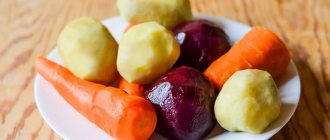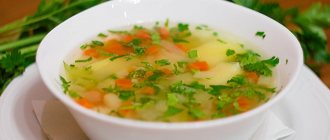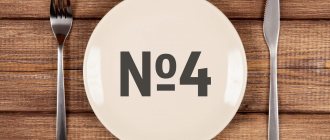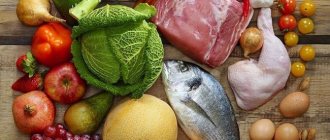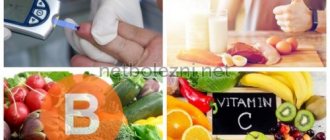Diets
- Diet No. 0: indications
- Dietary table No. 0: what is possible and what is not?
- Diet No. 0a
- Diet No. 0b
- Diet No. 0b
Diet No. 0 is one of the table systems developed by the Russian gastroenterologist M. Pevzner. The goals of this diet are the following: increasing the body's resistance and ensuring the supply of all substances that are necessary for its normal functioning; providing a small amount of food when its intake is very limited or difficult; unloading of the digestive organs to the maximum; prevention of flatulence.
Table No. 0 according to Pevzner has 3 restrictions , namely:
- Thermal. The temperature of food and drinks taken should be 35-45 degrees. If the food offered is too cold or hot, it can put undue stress on the stomach and intestines. It can also provoke excitement of the nervous system, which is unacceptable in case of brain damage.
- Mechanical. Products can only be consumed in the form of decoctions and broths; after some time, pureed soups and slimy porridges are allowed on the menu. In the final phases of the diet, you can add solid food, but always steamed or boiled.
- Chemical. Indigestible foods that provoke the production of gastric juice or gases in the intestines are removed from the diet. Avoid taking strong tea, coffee, salty and sour foods, spices and sauces.
What is diet number 0?
Chemical composition and energy value of dietary table No. 0A
Proteins: 5 g. Fats: 15–20 g. Carbohydrates: 150 g. Daily calorie content: 750–800 kcal. Free liquid: 1.8–2.2 l. Table salt: 1 g. Vitamins: up to 200 mg of vitamin C in each dish, other vitamins as prescribed by a doctor. Macroelements: as directed. Microelements: as directed. Optimal food temperature: 45 degrees Celsius.
Therapeutic diet No. 0: menu
Of course, the menu can be slightly adjusted after consulting with your doctor, but it roughly looks like this:
- At the first stage of the diet (No. 0a), you can prepare a light broth for the patient. It is better to take chicken or turkey meat. Cook from a whole piece of meat using a secondary broth. Under no circumstances should you salt it. When cooking, you can throw in carrots, but before serving to the patient, the root vegetable must be removed.
- At the second stage of the table (No. 0b), it is possible to eat buckwheat porridge. We take the proportion 1:3, cook the cereal in clean water. After cooking, rub the porridge through a sieve several times. Before serving, the dish must cool to the optimal temperature. You can add an omelette cooked in a double boiler to the buckwheat. In this case, you need to remove the yolk. You can also make meat soufflé. The recipe for this dish is simple: chicken meat – 100 g, one egg, 60 ml of milk. Boil the meat, cool, grind a couple of times, then pass through a blender. Separate the white and yolk. Mix the yolk with the meat, beat the white until foamy. Then mix everything, add milk and steam.
- At the third stage (No. 0c), nutrition is already more like complete nutrition. A one-day menu might look like this:
- Breakfast: semolina, linden tea;
- Snack: baked apple
- Lunch: vegetable puree soup, buckwheat porridge
- Snack: cottage cheese, pear compote;
- Dinner: turkey meat soufflé, tea.
According to patient reviews, proper adherence to a diet under the supervision of a doctor or nurse helps restore the functioning of the digestive system and switch to a nutritious diet
The diet is quite strict and does not provide the body with enough vitamins and minerals. To make the body’s recovery process less painful and more gentle, you must adhere to the doctor’s recommendations.
More interesting information on the topic in the video:
Recommended products and dishes of the diet table No. 0A
Soups: weak low-fat meat and fish broths, rice and oatmeal broths with butter or cream. Dairy products: cream if the condition improves no earlier than the 3rd day of the diet. Eggs: 1 pc. soft-boiled if the condition improves no earlier than the 3rd day of the diet. Sweet dishes: liquid jelly made from fruits, berries, dried fruits. Drinks: weak tea with milk, rosehip infusion, dried fruit infusion, freshly squeezed berry and fruit juices. Fats: unsalted fresh butter if the condition improves no earlier than the 3rd day of the diet.
Diet characteristics
The zero diet is a very strict diet. The patient’s recovery depends on how accurately all her instructions are followed. Table number 0 is indicated for weakened patients, therefore its functions:
- reducing the load from food intake on all internal organs, especially the digestive tract
- prevention of increased gas formation, flatulence
The founder of therapeutic nutrition M.I. Pevzner recommended 3 types of diet sparing.
Thermal sparing . The temperature of food and drinks should be comfortable for the digestive organs - from 35º to 45º. Cold and hot are prohibited, because... such food creates a high load on the gastrointestinal tract and stimulates the activity of the central nervous system (CNS).
Mechanical reduction . Food must be properly cooked or steamed, easily digestible, liquid or diluted. Products that have been pureed or minced several times through a meat grinder are recommended. Food containing coarse fibers is strictly prohibited.
Chemical sparing. Ingredients of food and drinks: only natural and high-quality products. Salt and sugar are added in limited quantities. Prohibited: synthetic additives, coffee in any form, strong tea, spices and sauces, sour and salty.
Diet 0 consists of three successive stages lasting an average of 2 to 4 days. These are tables 0A, 0B and 0B. As the patient's condition improves, the menu expands and a larger number of foods and dishes are allowed. The purpose of the diet is to gradually transfer the patient to a normal diet. Let's look at what you can and can't eat (and drink) at each stage.
Read also: Diet number 5 for liver and biliary tract problems
Sample diet menu No. 0A
08.00: 100 g of tea with sugar, 100 g of liquid jelly. 10.00: 180 g oatmeal broth with cream. 12.00: 150 g of fruit jelly, 150 g of dried fruit decoction. 14.00: 200 g of weak meat broth with butter. 16.00: 150–200 g of tea with lemon and sugar. 18.00: 180 g of rice water with butter, 100 g of fruit jelly. 20.00: 200 g berry juice. 22.00: 180 g of liquid from the compote.
Sources:
- Order of the Ministry of Health of the Russian Federation No. 330 “On measures to improve clinical nutrition in medical institutions of the Russian Federation” dated 05.08.2003
Table 0, recipes:
Blackcurrant jelly. 1½ tbsp. spoons of black currant berries, 1 tbsp. a spoonful of sugar, 1 teaspoon of potato starch, a few blackcurrant leaves, 200 ml of water.
Kissel is prepared only from ripe and juicy berries. Sort the currants and rinse well with cold water. Then squeeze out the juice, pour it into a bowl (possibly enamel) and refrigerate. Meanwhile, put the remaining mass in a saucepan, add hot water and boil for about 5 minutes along with washed currant leaves (optional). Then strain the broth through cheesecloth or a fine sieve. Pour sugar into the prepared broth, boil, and remove the foam from the surface with a slotted spoon. Pour starch diluted with cold water into the hot syrup and quickly bring to a boil while stirring vigorously. After brewing the starch into the jelly, immediately pour the cooled juice. Stir the prepared jelly well and pour into glasses. To prevent a film from forming on the surface of the jelly, you can sprinkle it with a small amount of sugar.
Rose hip decoction. For 20 g of rose hips, take 200 ml of water.
Sort out the dried rose hips, rinse with cold water, and lightly crush. Pour boiling water over it. Boil the fruits in a stainless steel container with a tightly closed lid. Leave in a cool place for at least 8 hours, preferably a day.
Steamed egg white omelette. Whites of 2 eggs, 60 g milk, 5 g butter, salt.
Carefully break the washed eggs, carefully separate the whites from the yolks. Whisk the whites with a small amount of salt, continue whisking, and pour in the milk. Pour the resulting mixture into greased and floured molds and cook in a water bath.
Soft-boiled egg. 1 egg, salt.
Place the washed egg in cold water, add a little salt. From the moment of boiling, cook for 3 minutes, then cool in cold water (so that the shell can be easily removed). You can serve it with a piece of fresh butter.
Based on the book by A. Sinelnikova “Dietary nutrition. Culinary recipes for your health."
Zero (surgical) diets
Indications:
1) after operations on the digestive organs; 2) in a semi-conscious state (cerebrovascular accident, traumatic brain injury, infectious diseases with high fever, etc.).
Destination purpose:
provide nutrition in conditions where eating regular food is impossible, difficult or contraindicated; maximum unloading and sparing of the digestive organs, prevention of intestinal bloating (flatulence).
General characteristics:
the most mechanically and chemically gentle nutrition (liquid, semi-liquid, jelly-like, pureed food) in the form of three sequentially prescribed diets - No. 0a, 0b, 0c. Diets contain the most easily digestible sources of proteins, fats and carbohydrates, increased amounts of fluids and vitamins. The amount of sodium chloride is sharply limited. Frequent meals in small portions.
Notes:
1. Diets No. 0b and No. 0c are sometimes called No. 1a and No. 1b surgical. 2. Enpits are indicated for zero diets (see “Canned food and concentrates”). 3. After zero diets, diet No. 1 or No. 1 surgical diet is used. The latter differs from diet No. 1 by the inclusion of weak meat and fish broths and vegetable broths and the limitation of whole milk.
Diet No. 0a.
As a rule, they are prescribed for 2 - 3 days.
The food consists of liquid and jelly-like dishes. The diet contains 5 g
of protein, 15 - 20
g
of fat, 150
g of
carbohydrates;
3.1 - 3.3 MJ
(750 - 800
kcal
);
free liquid - 1.8 - 2.2 l
, table salt - 1
g
.
Food temperature should not exceed 45°C. Up to 200 g
of vitamin C is added to the dish;
other vitamins - as prescribed. Meals 7 - 8 times a day, for 1 meal no more than 200 - 300 g
.
Allowed:
weak low-fat meat broth, rice broth with cream or butter, strained compote, liquid berry jelly, rosehip broth with sugar, fruit jelly, tea with lemon and sugar, freshly prepared fruit and berry juices, diluted 2-3 times with sweet water (up to 50
ml
per dose).
If the condition improves, on the 3rd day add: a soft-boiled egg, butter - 10 g
, 50
ml
of cream.
Excluded:
any dense and pureed dishes, whole milk and cream, sour cream, grape and vegetable juices, carbonated drinks.
Sample diet menu No. 0a.
8
hours
: 100
g
of warm tea with 10
g
of sugar, 100
g
of liquid fruit or berry jelly.
10 hours
: 180
g
of liquid from apple compote.
12 h
;
200 g
of weak meat broth with 10
g
of butter.
14 h
: 150
g
of fruit jelly, 150
g
of rosehip decoction.
16 hours
: 150 - 200
g
of tea with lemon and 10 - 15
g
of sugar.
18 hours
: 180
g
of rice water with 10
g
of butter or cream, 100 - 150
g
of fruit jelly.
20 hours
: 180
g
of rosehip decoction.
At night: 180 g
of compote liquid.
Diet No. 0b (No. 1a surgical).
Prescribed for 2 - 4 days after diet No. 0a, from which it differs in the addition of: liquid pureed porridge from rice, buckwheat, rolled oats, cooked in meat broth or water with 1/4 - 1/2 milk;
slimy cereal soups with vegetable broth, weak low-fat meat broths with semolina; steam protein omelet, soft-boiled eggs; steam souffle or puree from lean meat or fish (freed from fat, fascia, tendons, skin); up to 100 g
of cream, jelly, mousse from non-acidic berries.
The diet contains 40 - 50 g
of protein, 40 - 50
g
of fat, 250
g
of carbohydrates;
6.5 - 6.9 MJ
(1550 - 1650
kcal
), 4 - 5
g
sodium chloride, up to 2
liters
of free liquid.
Food is given 6 times a day, no more than 350 - 400 g
per meal.
Sample diet menu No. 0b (No. 1a surgical).
1st breakfast: liquid pureed buckwheat porridge on water - 200
g
with milk and 5
g
of butter, steamed white omelette of 2 eggs, tea with lemon.
2nd breakfast: cream - 100 g
, rosehip decoction - 100
g
.
Lunch: meat broth with semolina - 200 g
, steam soufflé from boiled meat - 50
g
, compote decoction - 100
g
.
Afternoon snack: soft-boiled egg, fruit jelly - 150 g
, rosehip decoction - 100
g
.
Dinner: steamed boiled fish soufflé - 50 g
, liquid pureed oatmeal porridge in meat broth - 200
g
with 5
g
of butter, tea with lemon.
At night: fruit jelly - 150 g
, rosehip decoction - 100
g
.
For the whole day - 50 g
of sugar and 20
g
of butter.
Diet No. 0b (No. 16 surgical).
Serves to continue expanding the diet and transition to physiologically nutritious nutrition.
The diet includes puree soups and cream soups, steamed dishes from pureed boiled meat, chicken or fish, fresh cottage cheese pureed with cream or milk to the consistency of thick sour cream, steamed dishes from cottage cheese, fermented milk drinks, baked apples, well-mashed fruit and vegetables puree, up to 100 g
of white crackers.
Milk is added to tea; milk porridge. In the diet - 80 - 90 g
of protein, 65 - 70
g
of fat, 320 - 350
g
of carbohydrates;
9.2 - 9.6 MJ
(2200 - 2300
kcal
);
6 - 7 g
sodium chloride. Food is given 6 times a day. The temperature of hot dishes is not higher than 50°C, cold food is not lower than 20°C.
Sample diet menu: 0c (No. 1b surgical).
1st breakfast: soft-boiled egg, semolina milk porridge - 200
g
with 5
g
of butter, tea with lemon and sugar.
2nd - breakfast: pureed cottage cheese with cream - 120 g
, baked apple puree - 100
g
, rosehip decoction - 180
g
.
Lunch: vegetable cream soup - 300 g
, steamed meat cutlets - 100
g
, fruit jelly - 150
g
.
Afternoon snack: steamed protein omelette, fruit juice - 180 g
.
Dinner: steamed boiled fish soufflé - 100 g
, pureed oatmeal porridge - 200
g
with 5
g
of butter, tea with 50
g
of milk.
At night: kefir - 180 g
.
For the whole day: 100 g
of premium wheat bread crackers, 60
g
of sugar, 20
g
of butter.

